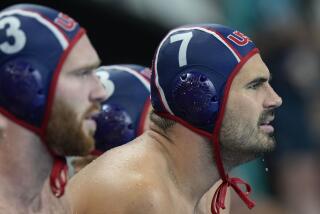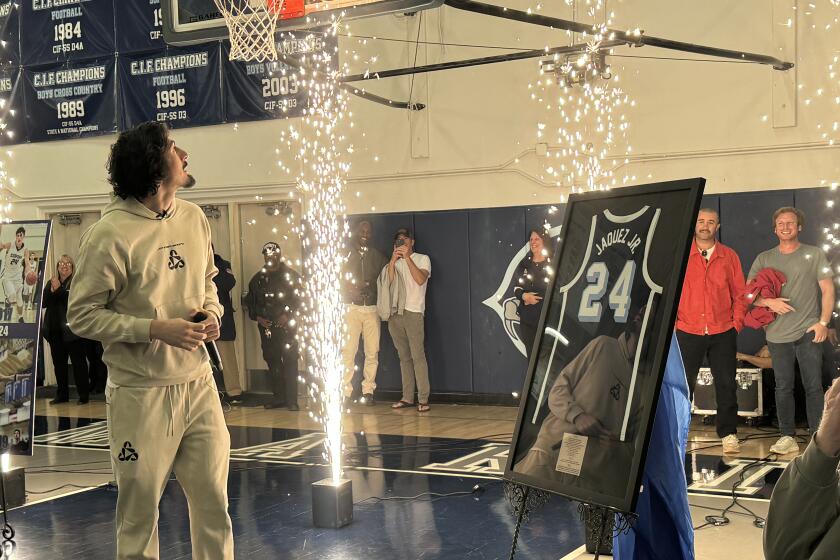SPORTS: THE NEXT DECADE : PERSONALITIES : The Stars: Think International : Sports Becomes More of a Global Village as World Series Will Truly Become World and Super Bowls Will Actually Become More Super
I will tell you now about some of the names you will be hearing in the ‘90s. But don’t hold me to it.
Anyone attempting to write a similar article in December, 1979, about the ‘80s may have had the same difficulty.
You needed no crystal ball to predict Magic Johnson, Larry Bird and Wayne Gretzky would dominate their sports. Magic and Bird led their teams to the NCAA championship game in 1979 and already were playing important roles in the NBA. Gretzky was only 18 and playing his first NHL season, but he already was on his way to leading the league in scoring.
But Joe Montana was a third-round draft choice in 1979 who was sitting on the bench as a rookie, a season in which he would throw only 23 passes.
Mike Tyson was a 13-year-old street mugger. Carl Lewis was a college freshman who had never met Ben Johnson. Flo had never met Jo. Bo Jackson and Michael Jordan were in high school. Boris Becker was 12. Steffi Graf was 10. Michael Chang and Janet Evans were 7.
ESPN was not quite a year old. The Big East had just been born. Fay Vincent was president of Columbia Pictures. Kirk Gibson was the seventh-round draft choice in 1979 of the St. Louis Cardinals--of the NFL. Every Angel pitcher had two hands.
Pro basketball had not come to Dallas, Charlotte, Miami, Orlando and Minnesota.
Pro football had not come to Phoenix and Indianapolis.
Would anyone have guessed that Shoeless Joe Jackson would make a comeback? Or that we would dread it every time Rocky did? Joe Torre was a manager. Pat Riley was a broadcaster. Slap Maxwell was an idea. The Goodwill Games were not even that, yet. Rotisseries and Refrigerators were household appliances. Anabolic steroids were only slightly less mysterious than the America’s Cup.
Who would have believed in miracles? Or earthquakes at the World Series? Rosie Ruiz, Hulk Hogan and Arena Football?
You get the point. Only a fool would try to predict who, what and where will make the sports headlines over the next decade. So here I go, starting with this:
Think international.
The NFL has a head start, scheduling its World League of American Football to begin play in the spring of 1991 with teams in Europe, Japan, Mexico, Canada and the United States. Don’t be surprised someday to see a Super Super Bowl between, say, San Francisco and Milan. How about a game matching the quarterback of the ‘90s, Todd Marinovich, and linebacker Keith McCants, who will be the next Lawrence Taylor?
At roughly the same time, the Lakers will be on a trip to Belgrade, Rome, Milan, Barcelona, Madrid and Athens in their annual visit to the teams in the IBA’s (International Basketball Assn.) European division. Wealthy owners such as Raul Gardini, who lured Danny Ferry and Brian Shaw to Rome this season, will be as well known as George Steinbrenner and Jerry Buss.
Gardini will pursue another leaning tower for Italy, Georgetown’s Alonzo Mourning. With Mourning and another Hoya alum, Patrick Ewing, the dominating center will return to pro basketball in the ‘90s. The dominating player, however, will be Michael Jordan. Tough one, huh?
There will be a true World Series, which will occur in the late ‘90s between the North American and Japanese baseball champions.
The Japanese are going to need some help. They can afford it. We’ll look back and laugh at the day when teams could sign a Mark Langston or Mark Davis for a mere $3 million a year.
One right-hander the Japanese will want to consider is Alex Fernandez, the only first-round draft choice in 1988 who did not sign with a major league team. Instead, he went to the University of Miami, where he made the freshman All-American team. Now, he has dropped out of school and is eligible for the draft again.
Another pitcher with a can’t-miss tag is Stanford’s Mike Mussina, a junior this season. Perhaps he will pitch for Tokyo for the world championship against Toronto, which will have as its clean-up hitter John Olerud, whose junior season at Washington State this year was interrupted by brain surgery. When he returned, he still looked like the pitcher-designated hitter who led the Northern Division of the Pacific 10 as a sophomore in victories, earned run average and home runs.
Japan will be the country of the ‘90s. Nagano, Japan, will be elected by the International Olympic Committee in 1991 as the site for the 1998 Winter Olympics. The patron of Nagano’s bid is one of the world’s richest man, Yoshiaki Tsutsumi. Also in the ‘90s, look for the IOC to award the Summer Olympics of 1996 to Melbourne, 2000 to Beijing and 2004 to a unified Berlin. The 1998 Winter Olympics will be awarded to Salt Lake City.
In the Winter Olympics, the Japanese will dominate women’s figure skating. The reigning world champion is Midori Ito, who is only 19 and could win gold medals in both 1992 in Albertville, France, and 1994 in Lillehammer, Norway. Behind her is Yuka Sato, the reigning world junior champion. If they don’t win, perhaps one of the Japanese-Americans, Kristi Yamaguchi of San Jose and Kyoko Ina of Englewood Cliffs, N.J., will. Or perhaps it will be a California blonde, Tisha Walker, now 15, of Thousand Oaks.
In the Summer Olympics, the U.S. women will challenge the Soviet Union in gymnastics. They will be led by Karolyi’s Kids, particularly Kim Zmescal of Houston. “It is a kindergarten now, but this kindergarten is going to the Olympics in 1992,” Coach Bela Karolyi says of his stable of young gymnasts in Houston.
The Flo-Jo of 1992 will be a sprinter called So-Jo, Dawn Sowell of LSU. Ready for 1996 will be Oxnard’s Angela Burnham, a freshman this year at UCLA; and Inger Miller, a high school senior from Pasadena. The next great long jumper will be University of Florida freshman Dion Bentley, who broke Carl Lewis’ 10-year-old national high school record.
Even if there weren’t so many questions about the future of East German sports, the U.S. women would be about to reclaim superiority in swimming. Looking like sure medal winners are the “Sweet 16s”: breaststroker Mary Ellen Blanchard of Atlanta, the grandaughter of Doc Blanchard; and a girl with the best name in the sport, Summer Sanders of Roseville, Calif. Of course, it’s not like Janet Evans, the Stanford freshman from Placentia, is only 17.
Graf, Becker and Tyson are hardly ready for retirement. Graf and Becker will face challenges. Tyson may not.
Jennifer Capriatti of Lauderhill, Fla., is being allowed to join the women’s tennis tour a few weeks before her 14th birthday this year. You may not be familiar yet with Yugoslavia’s 18-year-old Goran Ivanesevic, but Becker is. They’re both managed by Ion Tiriac.
Because of Tyson’s dominance, the heavyweight boxing scene is so dull that he can’t demand the multi-large paydays he thinks he’s worth. So he might abdicate his title, setting up a tournament to choose the new champion, 1988 gold medalist Ray Mercer perhaps, and then return to reclaim his belt.
Other names to remember for the ‘90s: former UCLA catcher Todd Zeile, a Thurman Munson type who is so promising that his team, the St. Louis Cardinals, let Tony Pena go; Robb Stauber, the Kings’ goaltender of the future; Phil Michelson, a left-handed golfer from San Diego who won the NCAA championship as a freshman this year at Arizona State; Andy Hampsten, who will be the second American to win the Tour de France; and Eric Lindros, a 16-year-old hockey player from Toronto who already has been touted by Sports Illustrated as the next Great One.
Then there’s jockey Kent Desormeaux. This year, at 19, he broke Chris McCarron’s record for victories in a year.
One other thing. You will hear much more about soccer in the ‘90s than you did in the ‘80s, primarily because the World Cup will be in the United States in 1994.
But whether the World Cup will raise soccer to major-sport status in the United States in the ‘90s remains to be seen. As someone once said, “Soccer is the sport of the future . . . and always will be.”
More to Read
Go beyond the scoreboard
Get the latest on L.A.'s teams in the daily Sports Report newsletter.
You may occasionally receive promotional content from the Los Angeles Times.










